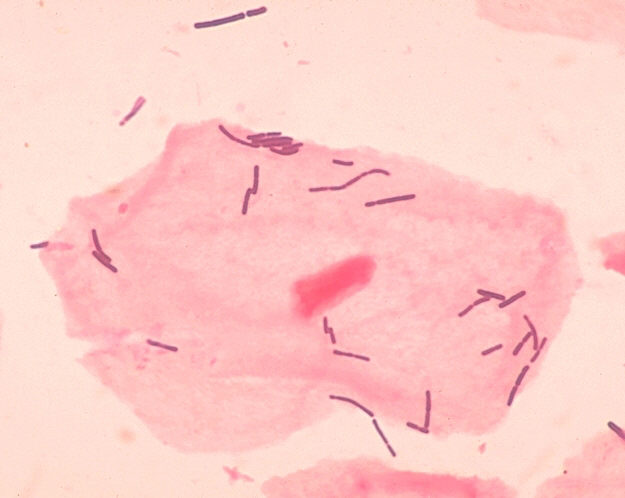Lactobacillus acidophilus
| Lactobacillus acidophilus | ||||||||||||||
|---|---|---|---|---|---|---|---|---|---|---|---|---|---|---|
 | ||||||||||||||
| Scientific classification | ||||||||||||||
| ||||||||||||||
| Binomial name | ||||||||||||||
| Lactobacillus acidophilus (Moro 1900) Hansen & Mocquot 1970 |
Lactobacillus acidophilus is one of several bacteria in the genus Lactobacillus. It is in some countries sometimes used commercially together with Streptococcus salivarius and Lactobacillus delbrueckii ssp. bulgaricus in the production of acidophilus-type yogurt. Also known as the Boas-Oppler bacillus after Ismar Isidor Boas, a German gastroenterologist (1858-1938) and Bruno Oppler (-1932) a German physician from Breslau.
Lactobacillus acidophilus gets its name from lacto- meaning milk, -bacillus meaning rod-like in shape, and acidophilus meaning acid-loving. This bacterium thrives in more acidic environments than most related microorganisms (pH 4-5 or lower) and grows best at 45 degrees Celsius. L. acidophilus occurs naturally in the human and animal gastrointestinal tract, mouth, and vagina.[1] L. acidophilus ferments lactose into lactic acid, like many (but not all) lactic acid bacteria. Certain related species (known as heterofermentive) also produce ethanol, carbon dioxide, and acetic acid this way. L. acidophilus itself (a homofermentative microorganism) produces only lactic acid. Like many bacteria, L. acidophilus can be killed by excess heat, moisture, or direct sunlight.
Health benefits
Some strains of L. acidophilus may be considered a probiotic or "friendly" bacteria.[2] These types of healthy bacteria inhabit the intestines and vagina and protect against some unhealthy organisms. The breakdown of nutrients by L. acidophilus produces lactic acid, hydrogen peroxide, and other byproducts that make the environment hostile for undesired organisms. L. acidophilus also tends to consume the nutrients many other microorganisms depend on, thus outcompeting possibly harmful bacteria in the digestive tract. During digestion, L. acidophilus also assists in the production of niacin, folic acid, and pyridoxine. L. acidophilus can assist in bile deconjugation, separating amino acids from bile acids, which can then be recycled by the body.[3]
Some research has indicated L. acidophilus may provide additional health benefits, including improved gastrointestinal function, a boosted immune system, and a decrease in the frequency of vaginal yeast infections. Some people report L. acidophilus provides relief from indigestion and diarrhea.[4] A University of Nebraska study found that feed supplemented with L. acidophilus and fed to cattle resulted in a 61% reduction of Escherichia coli 0157:H7. Research has indicated L. acidophilus may be helpful reducing serum cholesterol levels.[5]
L. acidophilus is part of the normal vaginal flora.[6] The acid produced by L. acidophilus in the vagina helps to control the growth of the fungus Candida albicans, helping to prevent vaginal yeast infections. The same beneficial effect has been observed in cases of oral or gastrointestinal Candidiasis infections. Certain spermicides and contraceptive creams can kill L. acidophilus in the vagina, clearing the path to possible yeast infections.
Antibiotics taken orally will also kill beneficial bacteria like L. acidophilus. After a course of antibiotic therapy, patients are occasionally instructed to take an L. acidophilus treatment in order to recolonize the gastrointestinal tract.
L. acidophilus is often sold in health stores in pill or powder form as a nutritional supplement. Research on the nutritional benefits of taking L. acidophilus supplements is inconsistent and inconclusive. Most such claims boil down to a link between L. acidophilus and a possible decrease in the incidence of certain diseases, including yeast infections, gastrointestinal disorders, and a weakened immune system. Most researchers agree further study is needed before substantiating many of these claims.
References
- ↑ "Bacteria Genomes - LACTOBACILLUS ACIDOPHILUS". European Bioinformatics Institute. Retrieved 2007-08-22.
- ↑ Ljungh A, Wadström T (2006). "Lactic acid bacteria as probiotics". Curr Issues Intest Microbiol. 7 (2): 73–89. PMID 16875422.
- ↑ Gilliland S, Speck M (1977). "Deconjugation of bile acids by intestinal lactobacilli". Appl Environ Microbiol. 33 (1): 15–8. PMID 13710.
- ↑ de Roos N, Katan M (2000). "Effects of probiotic bacteria on diarrhea, lipid metabolism, and carcinogenesis: a review of papers published between 1988 and 1998". Am J Clin Nutr. 71 (2): 405–11. PMID 10648252.
- ↑ Anderson J, Gilliland S (1999). "Effect of fermented milk (yogurt) containing Lactobacillus acidophilus L1 on serum cholesterol in hypercholesterolemic humans" (PDF). J Am Coll Nutr. 18 (1): 43–50. PMID 10067658.
- ↑ Forsum U, Holst E, Larsson P, Vasquez A, Jakobsson T, Mattsby-Baltzer I (2005). "Bacterial vaginosis--a microbiological and immunological enigma". APMIS. 113 (2): 81–90. PMID 15723682.
External links
- Article on health benefits of Lactobacillus acidophilus at MedlinePlus
- Article on Lactobacillus Acidophilus at University of Maryland Medical Center website
- Acidophilus and Other Probiotics
- Lactobacillus acidophilus from the U. of Wisconsin
- Lactobacillus Genome Project
- Global analysis of carbohydrate utilization by Lactobacillus acidophilus using cDNA microarrays
- Probiotics and the gastrointestinal tract: Where are we in 2005?
- Opportunities for Probiotic Dairy Products
- The role of Bifidobacterium bifidum and Lactobacillus acidophilus as probiotics in controlling infantile watery diarrhea
- Do probiotics reduce adult lactose intolerance? A systematic review
- Review of Scientific Evidence for Efficacy of Lactobacillus acidophilus DDS-1 as a Probiotic strain
- Acidophilus milk and its method of production
da:Lactobacillus acidophilus de:Lactobacillus acidophilus he:לקטובצילוס אצידופילוס it:Lactobacillus acidophilus nl:Lactobacillus acidophilus